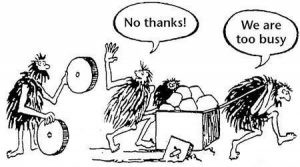Change can be hard – especially when it’s imposed on us.
 Why?
Why?
Because whether we admit it or not, we’re creatures of habit. We find comfort in being able to predict our environment and react accordingly. When that predictability goes away, so does our sense of security.
Smart Factories? Automation? Machines Communicating with One Another?
Much has been said about the Fourth Industrial Revolution: technologies that enable communication between equipment and computers. With the new technology now a days it has made mobile real estate management a lot easier. Some of it reads like the plot for the next Hollywood movie blockbuster where robots rule the world and humans suddenly find themselves the subservient population.
Thankfully, robots won’t be taking over the world anytime soon. But the ever-growing presence of robots in the workplace isn’t hyperbole.
The Fourth Industrial Revolution is Definitely Here
Self-driving cars, artificial intelligence, genetic engineering, mobile supercomputing…these are no longer futuristic concepts. They’re now our reality.
But, if past industrial revolutions have taught us anything, it’s the importance of embracing and adapting to change. Individuals, companies and industries that don’t evolve and adjust accordingly to the new technology often struggle, or worse yet, fail.
Usually, it’s the lack of truly understanding new technology – its purpose, how it works, the benefits of it – that makes the transition to using/working with it scary, especially for those who fear being unemployed because of it.
A Different Mindset
What if, instead of focusing on the perceived negatives of new technology – for our industry, the fear that automation and AI will result in millions of people out of work – we chose instead to focus on the opportunity potential – how these technological advances could actually make our lives easier and help us do our jobs more efficiently, accurately and safely?
“Shiny New Toy” Syndrome
For many, it’s always tempting to want to buy and try the very latest and greatest technology on the market – whether you need it and understand it or not. Why? Because these shiny new “toys” always seem to offer some new can’t-live-without benefit. You feel a sense of being left behind (and a fear of being smoked by the competition) if you don’t immediately jump on every bandwagon that drives past.
Jumping on the New Technology Bandwagon
The Industrial Internet of Things (IIOT) is a hot topic in the manufacturing industry. Many companies are viewing it as the next “holy grail” of condition monitoring, without having a full understanding of what “it” is and what it can give them or not give them. They’re jumping on the big data bandwagon, while simultaneously gutting their more traditional resources for condition monitoring (i.e. laying off personnel) in the name of optimization and reducing costs, because “they now have IIOT.”
However, they’re discovering that they’re receiving a tsunami of data informing them that they have lots of problems, but they no longer have the tools or qualified personnel to figure out the root of their issues or find a solution.
WHAT GOOD IS HAVING CONSTANT ACCESS TO LARGE AMOUNTS OF DATA IF YOU DON’T KNOW WHAT TO DO WITH IT?
A similar thing happened when wireless condition monitoring systems first came out. At first, these systems were perceived as being cheaper and easier because there were no wires involved. The result was, that even at a higher price point, these systems could be cost-justified. In turn, companies ended up trying to stick them on everything. More often than not, they put them on the wrong applications and the systems ultimately failed.
Unfortunately, many of the people who were authorizing and/or buying these systems weren’t qualified in the technology and therefore didn’t know the right questions to ask to make sure the equipment was a good fit.
OPPORTUNITY IS EVERYWHERE…YOU JUST HAVE TO LOOK FOR IT
At IVC, we welcome advancements in technology and view them as opportunities to expand our own knowledge and skills through researching, learning and understanding their capabilities. We can then help our clients figure out if and how this new technology might complement their existing reliability toolbox.
It may be new and exciting, but why make a huge investment in something that you may not need or that ultimately may not work for you?
